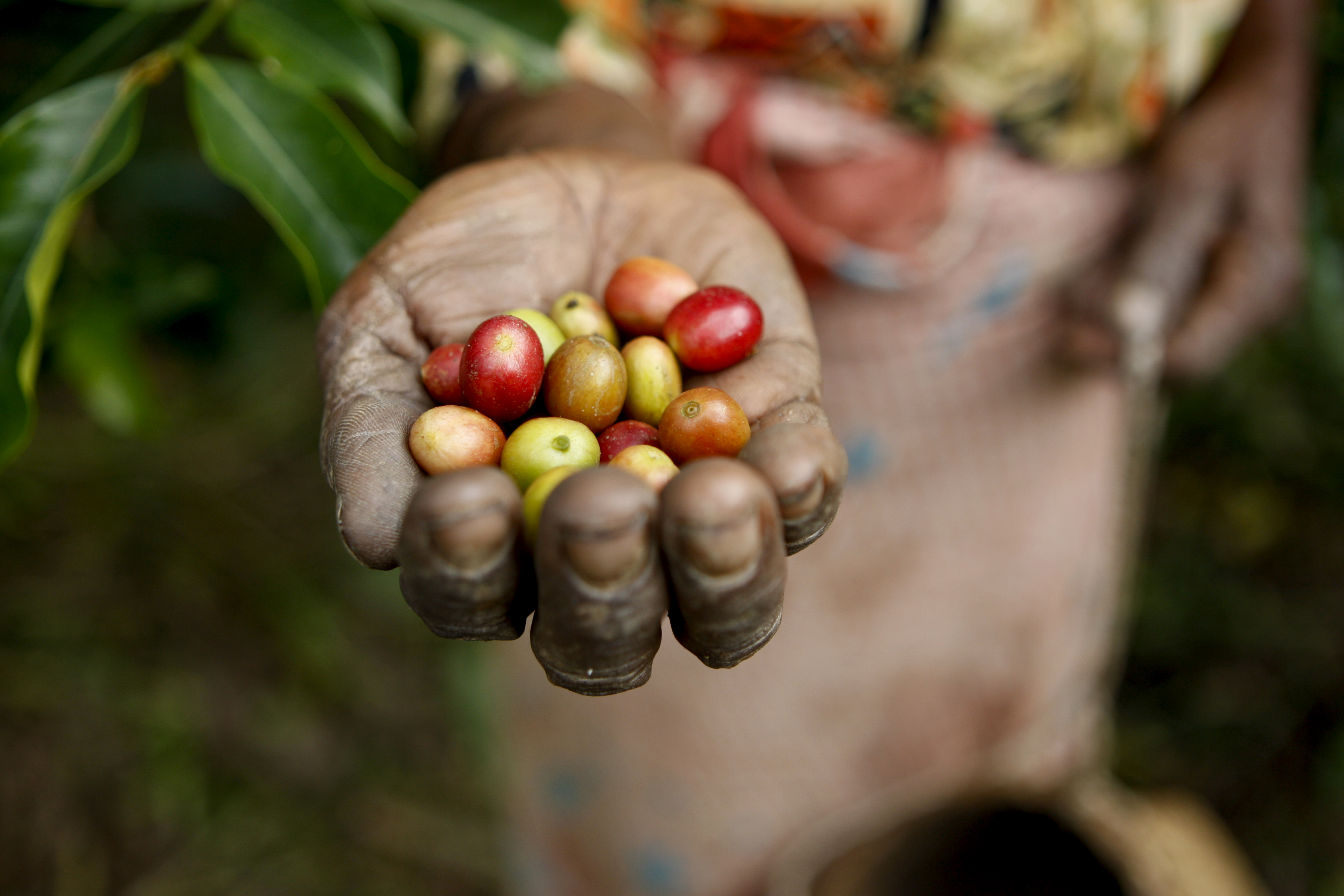For National Coffee Day, September 29, coffee shops around the nation are brewing up specials, from free “Pumpkin Pie” lattes to free coffee trees for Latin American farmers. In case you sleep in and miss out, International Coffee Day follows on October 1, a multi-nation celebration spearheaded by the International Coffee Organization. These holidays may seem like superfluous marketing moves—isn’t every day coffee day? But if you’re one of the 83-percent of Americans who drink coffee, or the 125 million people whose livelihood depends on it, contemplating the journey from bean to barista matters— because the future of our favorite brew, and of the farmers at the source, is at risk.
Coffee grows in a band straddling the equator, roughly between the Tropic of Cancer and the Tropic of Capricorn. Conservation International estimates that hotter summers and changing rain patterns could slash the coffee-growing area in half. Warmer temperatures have already led to the spread of coffee rust, a fungus that has devastated low lying crops in the past, and recently began attacking high-altitude areas of Mexico, Guatemala, and El Salvador, formerly protected by their relatively cooler climate.
Because coffee beans are largely traded as a commodity, farmers are vulnerable to market fluctuations from the supply side, driving many young people out of the industry. (The demand for coffee never shrinks, which comes as no surprise to a dedicated coffee lover like me.) While high-quality, sustainably farmed coffee is grown in the shade of taller trees, in the early 2000s, inexpensive coffee farmed through clear-cutting flooded the market. Growers of hand-picked, shade-grown coffee in places like Guatemala suddenly found the selling price lower than the cost of growing, sending some farmers in search of more stable, better paying work.
At the 2015 Paris climate meetings, Conservation International and coffee industry leaders launched the Sustainable Coffee Challenge, an effort to make coffee the world’s first sustainable agricultural product by ending all coffee farming through clear-cutting, increasing the productivity of farms, and improving farmers’ livelihoods, many of whom are women. More than one hundred partners have committed to the Challenge, including founding member Starbucks, McDonald’s, Walmart, and the Specialty Coffee Association.
As the Coffee Days approach, it’s time for coffee lovers everywhere to wake up to the role individuals can play in protecting our shared passion. Our purchasing power—$40 billion annually in the U.S. spent on coffee, or about $1,100 per person—gives us far more influence than we may realize. Here are some actions to take to preserve our favorite brew:
Buy certified coffee. The handful of popular certifications have real value. Organic, fair trade, UTZ, bird friendly, and Starbucks’ C.A.F.E. practices each mean something slightly different, but they all indicate that the coffee was grown in an environmentally friendly, socially conscious way, and that the farms were audited by an outside group. (One exception is the marketing term “all natural,” which isn’t a real certification.) For farmers, taking the (often expensive) steps needed to merit the certification allows them to disengage from the commodity market, and sometimes can command twice or triple the going price. We can learn about the differences, and choose coffee certified by a system most closely aligned to our values. Each certification explains itself in detail on its site. For a comparison, check out coffeehabitat.com/certification-guide/.
Ask your local coffee shop to carry certified or direct trade coffee. Consumer pressure absolutely drives businesses to make change. Sixty-six of percent of consumers say they’ll pay more for a sustainable product. As anyone who has stood in line at Starbucks for a tall vanilla latte can see, it’s possible to source ethically and succeed in business.
Recognize that Big ≠ Bad. Yes, you can drink Starbucks and feel good about it. Almost everyone in the coffee industry—from growers in Guatemala to international coffee experts—credit Starbucks with popularizing the idea of asking about the origin, and spending nearly two dollars for a cup. The wonderful, independent coffee shops around the country are thriving, in part, because Starbucks has created the demand for better brew. For 2015, Starbucks launched the One Tree for Every Bag initiative, donating the cost of a new tree for every bag sold; Conservation International worked with partners on the ground in Guatemala, El Salvador, and Mexico to plant the trees. Starbucks has also committed $50 million by 2020 to a Global Farmer Fund and is working closely with partners such as Root Capital, the Fairtrade Access Fund, the International Finance Corporation, and the Inter-American Development Bank to provide credit to farmers and cooperatives to make investments to ensure coffee quality, sustainability and overall profitability of a farm.
If you’re a business owner, do well by doing good: Coffee has one of the most transparent supply chains of any agricultural product, meaning you can find out who grew the beans you’re brewing for employees and/or customers. Not sustainably sourced? Switch.
Drink more coffee. In one recent study published in The Archives of Internal Medicine, women who drank four or more cups of coffee a day were 20 percent less likely to be depressed than study participants who weren’t downing so much joe. Sure, there is such a thing as drinking too much coffee; it can wreak havoc on your nerves and cause stomach distress. But, keeping your own physiology in mind, the easiest way to support the coffee economy? Order another cup—and pay attention to where it originated.
Jane Mosbacher Morris is the Founder and CEO of TO THE MARKET, a business that powers the ethical supply chain for the next generation of consumers. Her upcoming book, Buy the Change You Want to See: Use Your Purchasing Power to Make the World a Better Place (Penguin Random House/Tarcher Perigee), will be released January 29th , 2019.


